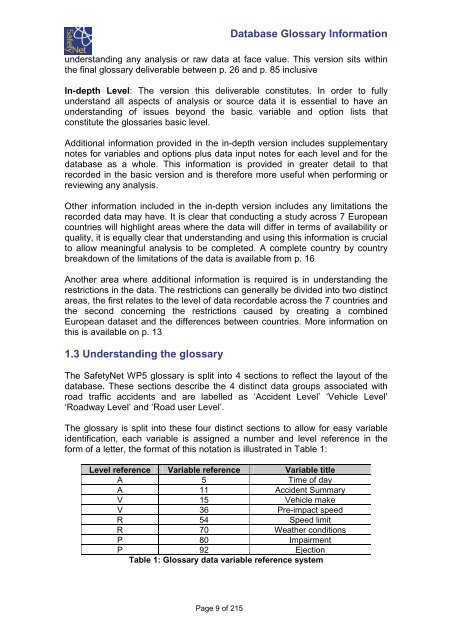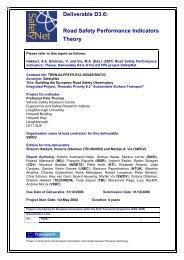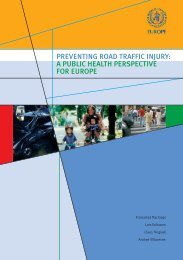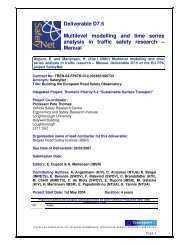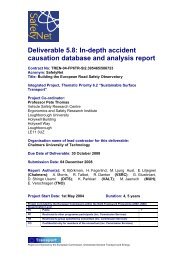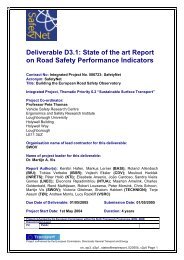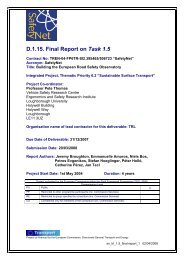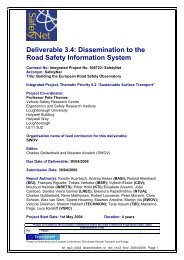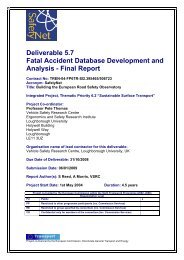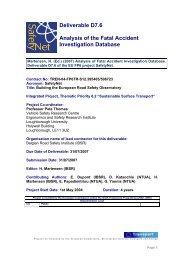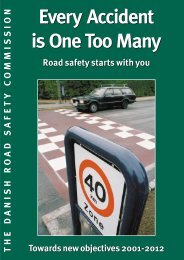Glossary of Data Variables for Fatal and accident causation ... - ERSO
Glossary of Data Variables for Fatal and accident causation ... - ERSO
Glossary of Data Variables for Fatal and accident causation ... - ERSO
You also want an ePaper? Increase the reach of your titles
YUMPU automatically turns print PDFs into web optimized ePapers that Google loves.
<strong>Data</strong>base <strong>Glossary</strong> In<strong>for</strong>mation<br />
underst<strong>and</strong>ing any analysis or raw data at face value. This version sits within<br />
the final glossary deliverable between p. 26 <strong>and</strong> p. 85 inclusive<br />
In-depth Level: The version this deliverable constitutes. In order to fully<br />
underst<strong>and</strong> all aspects <strong>of</strong> analysis or source data it is essential to have an<br />
underst<strong>and</strong>ing <strong>of</strong> issues beyond the basic variable <strong>and</strong> option lists that<br />
constitute the glossaries basic level.<br />
Additional in<strong>for</strong>mation provided in the in-depth version includes supplementary<br />
notes <strong>for</strong> variables <strong>and</strong> options plus data input notes <strong>for</strong> each level <strong>and</strong> <strong>for</strong> the<br />
database as a whole. This in<strong>for</strong>mation is provided in greater detail to that<br />
recorded in the basic version <strong>and</strong> is there<strong>for</strong>e more useful when per<strong>for</strong>ming or<br />
reviewing any analysis.<br />
Other in<strong>for</strong>mation included in the in-depth version includes any limitations the<br />
recorded data may have. It is clear that conducting a study across 7 European<br />
countries will highlight areas where the data will differ in terms <strong>of</strong> availability or<br />
quality, it is equally clear that underst<strong>and</strong>ing <strong>and</strong> using this in<strong>for</strong>mation is crucial<br />
to allow meaningful analysis to be completed. A complete country by country<br />
breakdown <strong>of</strong> the limitations <strong>of</strong> the data is available from p. 16<br />
Another area where additional in<strong>for</strong>mation is required is in underst<strong>and</strong>ing the<br />
restrictions in the data. The restrictions can generally be divided into two distinct<br />
areas, the first relates to the level <strong>of</strong> data recordable across the 7 countries <strong>and</strong><br />
the second concerning the restrictions caused by creating a combined<br />
European dataset <strong>and</strong> the differences between countries. More in<strong>for</strong>mation on<br />
this is available on p. 13<br />
1.3 Underst<strong>and</strong>ing the glossary<br />
The SafetyNet WP5 glossary is split into 4 sections to reflect the layout <strong>of</strong> the<br />
database. These sections describe the 4 distinct data groups associated with<br />
road traffic <strong>accident</strong>s <strong>and</strong> are labelled as ‘Accident Level’ ‘Vehicle Level’<br />
‘Roadway Level’ <strong>and</strong> ‘Road user Level’.<br />
The glossary is split into these four distinct sections to allow <strong>for</strong> easy variable<br />
identification, each variable is assigned a number <strong>and</strong> level reference in the<br />
<strong>for</strong>m <strong>of</strong> a letter, the <strong>for</strong>mat <strong>of</strong> this notation is illustrated in Table 1:<br />
Level reference Variable reference Variable title<br />
A 5 Time <strong>of</strong> day<br />
A 11 Accident Summary<br />
V 15 Vehicle make<br />
V 36 Pre-impact speed<br />
R 54 Speed limit<br />
R 70 Weather conditions<br />
P 80 Impairment<br />
P 92 Ejection<br />
Table 1: <strong>Glossary</strong> data variable reference system<br />
Page 9 <strong>of</strong> 215


